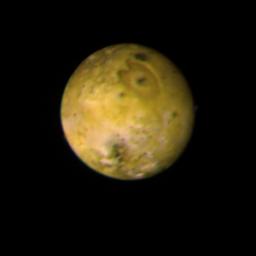
|
Io - Jupiter’s inner satellite
- Click the image above for a larger view
- Full-Res JPEG (300 x 300) (4.9 kB)
- Full-Res TIFF (300 x 300) (95.4 kB)
Caption:
The trailing face of Jupiter's inner satellite Io is shown in this photo taken by Voyager 1 on March 3, 1979, from a distance of 1.7 million miles. A bright yellow-orange equatorial band (lower left to upper right) separates the darker reddish-brown polar zones. The north pole is at upper left. Characteristic of Io's surface is the profusion of dark spots commonly surrounded by rings of brighter material. The smallest dark spot visible in this view is 30 kilometers wide; the largest, on the left is about 400 kilometers across. The large heart-shaped feature with a dark spot near its center could be Io's equivalent of an impact basin such as Mare Orientale on the Moon. Its outer dimensions are about 800 by 1000 km. It is located near (15 S by 260 W). Subsequent high-resolution coverage should reveal whether the small dark spots are impact craters, or perhaps something more exotic such as volcanoes. The reddish color of Io has been attributed to sulfur in the salts which are believed by some to make up the surface of Io. Water frost, which occurs on the surfaces of the other Galilean satellites, is absent on Io.
Background Info:
JPL manages and controls the Voyager project for NASA's Office of Space Science.
Cataloging Keywords:
| Name | Value | Additional Values |
|---|---|---|
| Target | Io | |
| System | Jupiter | |
| Target Type | Satellite | |
| Mission | Voyager | |
| Instrument Host | Cassini Orbiter | Voyager 1 |
| Host Type | Orbiter | Flyby Spacecraft |
| Instrument | Imaging Science Subsystem (ISS) | |
| Detector | ||
| Extra Keywords | Atmosphere, Color, Crater, Impact, Moon, Storm, Volcano, Water | |
| Acquisition Date | ||
| Release Date | 1999-07-16 | |
| Date in Caption | 1979-03-03 | |
| Image Credit | NASA/JPL | |
| Source | photojournal.jpl.nasa.gov/catalog/PIA01986 | |
| Identifier | PIA01986 | |
